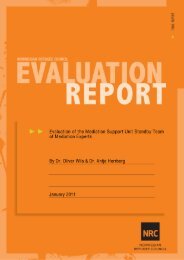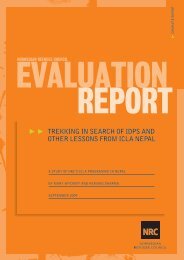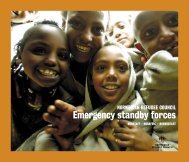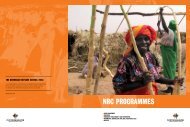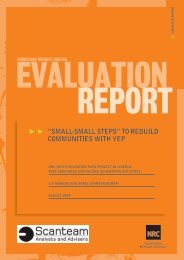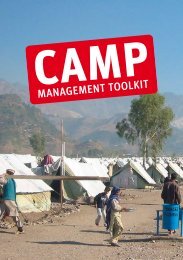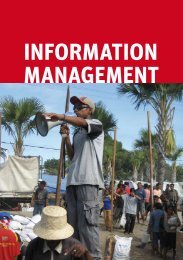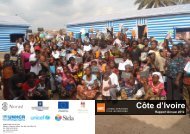evaluation of general food distribution in northern uganda: gulu ...
evaluation of general food distribution in northern uganda: gulu ...
evaluation of general food distribution in northern uganda: gulu ...
Create successful ePaper yourself
Turn your PDF publications into a flip-book with our unique Google optimized e-Paper software.
approaches through which it can stimulate a debate on transitional issues among therelevant actors <strong>in</strong> Uganda <strong>in</strong> order to br<strong>in</strong>g some coherence to the process .Strengthen<strong>in</strong>g Local Capacities: At an operational level, GFD is build<strong>in</strong>g the capacity <strong>of</strong>local structures (albeit on a limited scale) that are expected to direct future developmentefforts with<strong>in</strong> the community. Whereas it created its own <strong>distribution</strong> structures (the FMCs)which have been accused <strong>of</strong> underm<strong>in</strong><strong>in</strong>g the authority <strong>of</strong> local structures, NRC is<strong>in</strong>creas<strong>in</strong>gly work<strong>in</strong>g with local <strong>of</strong>ficials at the parish level <strong>in</strong> the transit sites and return a reas.Parish chiefs and local council <strong>of</strong>ficials are more <strong>in</strong>volved <strong>in</strong> the <strong>food</strong> <strong>distribution</strong> processesand have been tra<strong>in</strong>ed and equipped with community mobilization and leadership skills 168 .Dur<strong>in</strong>g the first quarter <strong>of</strong> 2008, a tra<strong>in</strong><strong>in</strong>g programme was conducted <strong>in</strong> all sub counties forFMCs, sub-county leaders and some LC members. The tra<strong>in</strong><strong>in</strong>g tackled topics on the roles <strong>of</strong>FMC/LCs, <strong>distribution</strong> processes, role <strong>of</strong> <strong>food</strong> aid dur<strong>in</strong>g return and recovery, hygienepromotion and domestic violence 169 .L<strong>in</strong>kages with Other NRC Programmes: NRC has a portfolio <strong>of</strong> programmes <strong>in</strong>clud<strong>in</strong>gsupport to <strong>food</strong> security & livelihoods (FSL); support to Information Communication andLegal Aid (ICLA); support to Food For Education (FFE), support to Education, <strong>in</strong> particularthe Youth Education Pack (YEP) and support to Shelter and Camp Management. All theseprogrammes have a longer-term perspective that would complement the GFD programme.Interest<strong>in</strong>gly GFD is credited for creat<strong>in</strong>g a special status for NRC, which has <strong>of</strong>fered somelevel <strong>of</strong> protection for the other programmes 170 and yet until recently, there have been noefforts to strengthen the l<strong>in</strong>kages between these programmes and GFD and maximise on this‘good will’.The FSL project which <strong>of</strong>fers a variety <strong>of</strong> livelihood options through agricultu ral production;<strong>in</strong>come generat<strong>in</strong>g activities (IGAs); and environmental conservation, was <strong>in</strong>itiated towardsthe end <strong>of</strong> 2005 with the aim <strong>of</strong> <strong>in</strong>creas<strong>in</strong>g IDPs’ self sufficiency, follow<strong>in</strong>g reductions <strong>of</strong> WFP<strong>food</strong> rations 171 . The programme picked pace <strong>in</strong> 2006. The FSL project targets both NEVIsand EVIs and is today (2008) work<strong>in</strong>g with a total <strong>of</strong> 7613 households <strong>in</strong> Gulu, Amuru andKitgum districts, but would like to expand its target group, as the needs are great. Support t<strong>of</strong>armer groups has so far <strong>in</strong>cluded <strong>in</strong>put provision (seeds, oxen, ploughs) and tra<strong>in</strong><strong>in</strong>g to<strong>in</strong>crease appropriate knowledge and skills. By creat<strong>in</strong>g knowledge on, strengthen<strong>in</strong>g anddevelop<strong>in</strong>g sources <strong>of</strong> <strong>food</strong> and sources <strong>of</strong> cash, the project assists IDPs and returnees tocope with their current situation <strong>in</strong> the short term as well as to ga<strong>in</strong> skills that will benefit themwhile return<strong>in</strong>g to their places <strong>of</strong> orig<strong>in</strong> 172 . The FSL project <strong>in</strong> its current scope is fully fundeduntil April 2009.The number <strong>of</strong> households so far reached by the FSL project appear rela tively small <strong>in</strong> light<strong>of</strong> the high unmet need for livelihoods support <strong>in</strong> the three districts, and hence the need toexpand these <strong>in</strong>terventions. As noted <strong>in</strong> earlier sections, NRC’s GFD and FSL componentscould complement each others’ efforts more than has be en the case, given their common<strong>in</strong>terest <strong>in</strong> <strong>food</strong> security. Apart from a few occasions, the two have to some degree beenwork<strong>in</strong>g <strong>in</strong> parallel. While their approaches to <strong>food</strong> security are somewhat different with theFSL component requir<strong>in</strong>g more technical back stopp<strong>in</strong>g and close monitor<strong>in</strong>g, GFD br<strong>in</strong>gscerta<strong>in</strong> strengths to the table (logistics, mobilization skills, a broad network, regular contactwith, and knowledge <strong>of</strong> communities <strong>in</strong> all sub-counties) some <strong>of</strong> which could be harnessedto <strong>in</strong>form and/ or support expansion <strong>of</strong> the livelihoods’ <strong>in</strong>terventions.168FFL/FFE Quarterly report, April 2008169Ibid170Interview with ICLA, NRC171Based on recommendations from a WFP EFSA conducted <strong>in</strong> March 2005172NRC: Food Security & Livelihoods leaflet48





